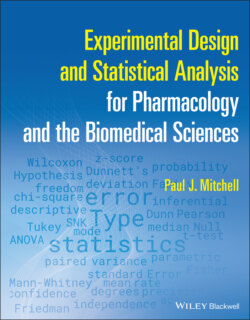Читать книгу Experimental Design and Statistical Analysis for Pharmacology and the Biomedical Sciences - Paul J. Mitchell - Страница 27
Example 3.3
ОглавлениеIn contrast, consider a second, albeit similar, experiment. Here the initial set‐up is different in that six aliquots from the stock solution are placed in a multi‐well plate. Drug or serum is then added to three of the wells, the other three wells are the controls. All wells are then left to incubate for three days. At the end of the incubation period, four samples from each of these wells are placed on a haemocytometer and the cells were counted. This process is summarised in Figure 3.3, but note the important step of adding drug or serum to three samples independently prior to incubation.
Figure 3.3 Multiple estimates of cell population in quadruplicate.
In this latter example, the cell population from each initial aliquot is subsequently measured in quadruplicate to improve the precision of the final population value by taking more than just one reading. However, the fact that samples were taken from flask and drug or serum added prior to incubation now means that there are three independent wells containing medium alone or with drug or serum during the incubation period. Consequently, we now have three independent estimates of the cell population each of which has been estimated in quadruplicate, i.e. we now have n = 3 estimations of cell growth over the three days of incubation.
Note that the measurements in quadruplicate still only provide an n of 1 for each original aliquot, but the fact that we now prepared three aliquots means that we now have n = 3 for each flask. This is useful because we can now perform some meaningful analysis of the cell populations exposed to drug or serum compared with our control group.
